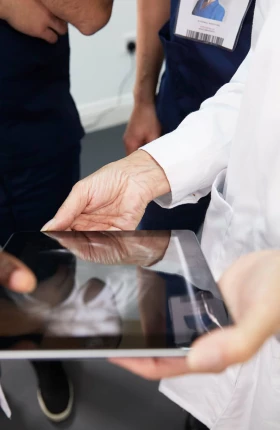A sea change is underway in how companies win regulatory approval for new health care products—particularly in the use of digital technology—and which markets they prioritize.
The $550 billion global medtech industry is becoming connected and digitized at an unprecedented rate, posing challenges for regulatory agencies and payers that often lack the expertise and capacity to keep pace with rapidly evolving technologies. To assess the current regulatory landscape for medtech and digital innovation, BCG and UCLA Biodesign collaborated on a research project examining the review process for medical device registrations. UCLA Biodesign surveyed more than 100 senior executives at medtech companies, representing 105 successful medical product registrations between 2010 and 2021; BCG assisted in designing the study, offering insights, and preparing the report. The results show that a sea change is underway in the industry with regard to the preferred path to bring new products to market.
Companies long considered the EU to be the most desirable region for launching new medtech products, because the process for obtaining a CE mark—the requirement to distribute medical products in Europe—seemed faster, cheaper, and more predictable than the regulatory review processes in other regions. No more. The US Food and Drug Administration (FDA) has invested heavily to keep pace with digital trends and has earned widespread praise from global industry for its efforts. As a result, the US has emerged as the go-to market for global launch.
In our findings, 79% of respondents strongly agree or somewhat agree that the FDA is responding effectively to advancements in medical technology. On the narrower topic of whether authorities are adapting to changes brought about by digital technology, 64% of US respondents say the FDA is managing well, versus only 34% of EU respondents who say that region’s authorities are doing so.
That gap may be widening. New requirements in Europe—particularly the Medical Device Regulation (MDR), which took effect in mid-2021—have increased the complexity of gaining a CE mark. Those developments, combined with factors such as Brexit and intense reimbursement pricing pressure, make the EU market less attractive. One survey respondent, the CEO of a cardiac device company based in Europe, put the case bluntly: “MDR is killing innovation.”
As a result of these shifts, 89% of companies say they will prioritize US regulatory approval going forward, and 23% of companies with successful CE mark products say they will pursue Japanese and Chinese registration prior to EU clearance.
Products that incorporate AI and machine learning compound the challenge of regulatory uncertainty. Companies are developing these products at accelerating rates. Of the 343 approvals of such products by the FDA since 1997, more than half occurred in 2019 and 2020. Because they are innovative, these products demand greater expertise on the part of reviewers and more regulatory clarity for companies.
Despite the ongoing challenges that global regulatory reviews face, reimbursement remains the leading barrier to medical innovation across all companies, cited by 55 of the 73 CEOs and regulatory leaders in our sample. For example, only 40% of respondents believe that the US Centers for Medicare and Medicaid Services provides clear decision criteria for benefit coverage and medical technology payment. Leaders broadly called for greater coordination between regulatory and reimbursement agencies and for creation of a separate reimbursement classification for digital products.
Our study includes directional benchmarking information about the cost and time required to bring new products to market, including minimum, maximum, and median data for various types of medical product clearances. It also offers specific recommendations for various stakeholders: medtech executives, regulators, payers, and investors.
With regard to the study’s quantitative and qualitative findings, our immediate goal in conducting this survey is to stimulate a discussion and encourage stakeholders to adopt best practices across industry and governing bodies. The long-term goal? To accelerate the development and launch of medtech innovations that improve the lives of patients.






